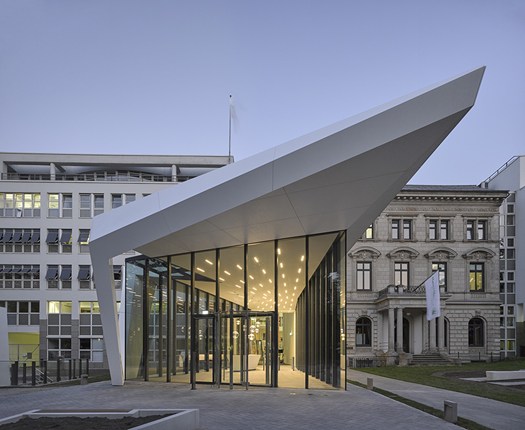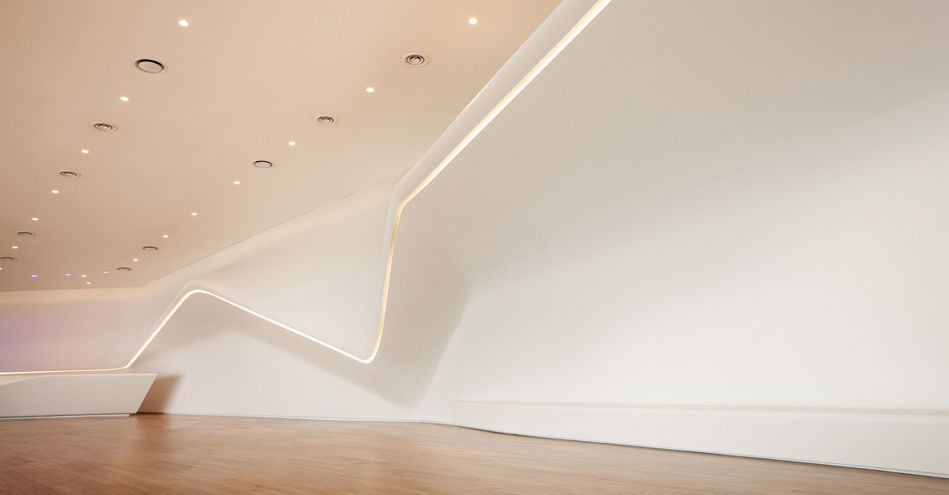An Architect’s Guide To: Solid Surfaces

Find the perfect solid surfaces for your next project through Architizer’s community marketplace for building-products. Click here for more information. It’s free for architects.
In just over 50 years, solid surfacing has taken off as a remarkably popular and enduring building material for both interior and exterior applications. In the past, solid surfaces have been most frequently used to create beautifully seamless countertop installations; more recently, however, architects have also perfected their usage across large-scale and completely unexpected facades, making them both a fascinating and temporal material for experimentation and study.

Brunhais House by Rui Vieira Oliveira Arquitecto features DuPont‘s Corian
The revolution began with DuPont’s Corian. First developed in 1967, the invention was driven by the idea of creating a surface that resembled marble or granite, but unlike natural stone, was non-porous and therefore better fortified against cracking and internal damage. When DuPont’s patent expired, other manufacturers including Avonite, HI-MACS, Porcelanosa and many more began fabricating materials that could serve similar functions.
One thing to remember is that solid surfaces are neither easy to manufacturer nor install. Therefore, it is very important to work with an authorized retailer from the outset of the design process, and insist upon a trained fabricator and installer on site.

Office Building by Garc SpA is clad in KRION’s Lux 1100 Snow White solid surfacing; image via Porcelanosa
Materials
What exactly constitutes this supremely versatile material? A solid surface is a human-made composite that is approximately one-third binding resins and a remaining two-thirds minerals. For reference, a typical precious stone countertop is only about 10% resins, which means that the mineral portions — marble, granite or otherwise — are more visible and easily decipherable. Solid surfaces, on the other hand, often take on a more visually consistent appearance.

HanseMerkur by Wasfy Taha and Querkopf-Architekten features a sculptural entrance clad in HI-MACS solid surfacing; image via HI-MACS
Most solid surfaces are a combination of Alumina Trihydrate (ATH), acrylic, resins and pigments. The secret sauce — ATH — is a very fine white powder that helps maintain the surface’s smooth consistency. Two common types of solid surface systems are polyester-based and acrylic-based; the main differentiation lies in their resins.
Polyester-Based: Today, polyester-based solid surfaces are going largely out of fashion to their acrylic-based counterparts. Polyester is more brittle than acrylic, which means that there is a higher likelihood of breakage during transportation and fabrication. In addition, it is more difficult to achieve a perfectly seamless solid seam with polyester.
However, there are advantages to polyester-based solid surfaces. Not only are they cheaper, but they are also easier to impart with dramatic vibrant colors and high-gloss finishes, as displayed by Avonite’s brilliant Studio Collection. Depending on your aesthetic preferences, polyester could be the right choice for your project.

Solid surface acrylic wall coverings by Staron; image via Staron
Acrylic-Based: Today, acrylic-based solid surfaces are monopolizing the market, with a strong hold on approximately 80% of all products. Reflecting this shift, brands like Staron are now 100% acrylic while others like Formica, are currently in transition. Acrylic-based solid surfaces are stronger than polyester, and therefore make it easier for manufacturers to deliver a damage-free product to site.
Aesthetically, acrylic surfaces look best when they are finished with a lower-gloss than polyester, which may be desirable depending on the context of your project. However, acrylic-based solid surfaces are sometimes criticized for lacking the luster and beautiful depth associated with natural stone.
Finally, acrylic is the best choice if you are planning on pursuing fancy fabrication work such as thermoforming; acrylic solid surfaces can bend at more dramatic and fluid shapes than polyester.
Aesthetics
One of the most sought after qualities of solid surfacing is its aesthetic flexibility and formability. The design iterations of solid surfacing are virtually endless. For example, DuPont’s Corian is a material “on which to innovate,” and one upon which the most daring creative visions may flourish. Typically manufactured in sheet form, solid surfaces can be cast into endless variety of shapes, exemplified by the material’s usage across exterior cladding, wall panels, countertops, sinks and even sculptural art.
Thermoforming: Thermoforming is an increasingly popular way of creating 3-D and rounded shapes with solid surface materials. The process involves heating the composite material in an oven until it becomes flexible and malleable.
When heated to the appropriate temperature, acrylic material is far more flexible to work with than polyester. It is important to acknowledge that thermoforming may cause certain alterations to the material; for example, when heated the material may shrink or darken in color. Talk to you manufacturer early on about the geometric and aesthetic qualities that hope to achieve with your final project.

Corian sink by DuPont; image via E-Architect
Color: Color flexibility is a key reason for choosing engineered composites over natural stone as it can multiply your design possibilities. One important thing to note is that rather than being coated in a color, the color pigment goes all the way through the surface. This means that there is homogeneity throughout the material and very little opportunity for color chipping or visible imperfections.

Cosentino’s Dekton Ortix
Pattern: Solid surfaces are not only available in solid hues, but also sweeping veining patterns. Top surface manufacturers are fabricating varying degrees of translucency as well as patterns inspired by quartz and other precious stones for an upscale look. For further inspiration on cutting edge surface design, check out Architizer’s article, Cosentino’s Dekton Industrial Series Gives History New Life.
Finishes: Solid surface products are available in a variety of finishes, ranging from matte to high-gloss. Most manufacturers recommend a matte or satin finish for simple maintenance.

Anansi by Mulders vandenBerk Architecten features engraved solid surface cladding by DuPont
Engraving and Perforation: During the production process, solid surfacing can be cut to create intricate designs. As displayed in Architizer’s collection, On the Surface: 5 Strikingly Detailed, Solid Surface Façades, many architects are harnessing this quality to create uniquely engraved and perforated building envelopes.
Performance
Compared to its material competitors such as wood, tile and laminate, solid surfacing is easier to clean, maintain and roll out in very large formats.
Environmental Considerations: Today, many solid surfaces contain recycled content, meaning that they can be serve as a sustainable material choice for your project. Typically, these products are made from both reclaimed solid surfacing and various types of post-industrial waste. In addition, many of today’s leading edge products, including KRION by Porcelanosa, are manufactured to be 100% recyclable and can be repurposed at the end of their lifecycle.

Seeko’o Hotel by atelier d’architecture King Kong is clad in DuPont’s Corian solid surfacing
Porosity: In researching solid-surfaces, one term that you will come across time and time again is “non-porous”. While no surface is ever completely non-porous, solid surfaces are just about as close as it gets, which renders an impermeable shield that greatly promotes durability.

Matte black countertop composed of Porcelanosa’s KRION
Durability: With a non-porous surface and gelcoat finish, solid surfaces are intrinsically resistant to bacteria, fungal growth and staining — issues that are common among wood and stone especially. These qualities make solid surfacing an apt choice in healthcare and hospitality environments, and any other setting with highly specific hygiene codes.
Further, Porcelanosa’s most recent development — KLIFE — is a shade of KRION that possesses both air purification and self-cleaning capabilities. When it comes to the durability performance of solid surfacing, we will continue to see innovations like this in building-product design.
Maintenance: The non-porosity of solid surfaces also gives way to simple reparations when any scuffing does occur. Easy to fix, imperfections can usually be sanded off or re-polished by a solid surface repair company or trained fabricator.
Case Studies

Bieblova Apartments by P6PA+Architects features cladding by HI-MACS
5 Strikingly Detailed, Solid Surface Façades
Solid surface cladding, like its interior counterpart, is created from a mixture of acrylics, pigments and resin. The result is a homogeneous material that can be sliced, scribed, sculpted and sanded without weakening its structural integrity or its water-resistant finish. From originators like DuPont Corian, to newcomers like Krion and HI-MACS, several manufacturers have developed cladding products that bring this remarkably versatile material to the surface.
Find the perfect solid surfacces through Architizer’s community marketplace for building-products. Click here to sign up now.
The post An Architect’s Guide To: Solid Surfaces appeared first on Journal.
, Architizer Editors, read more Journal http://ift.tt/2BxbAcF


Yorumlar
Yorum Gönder